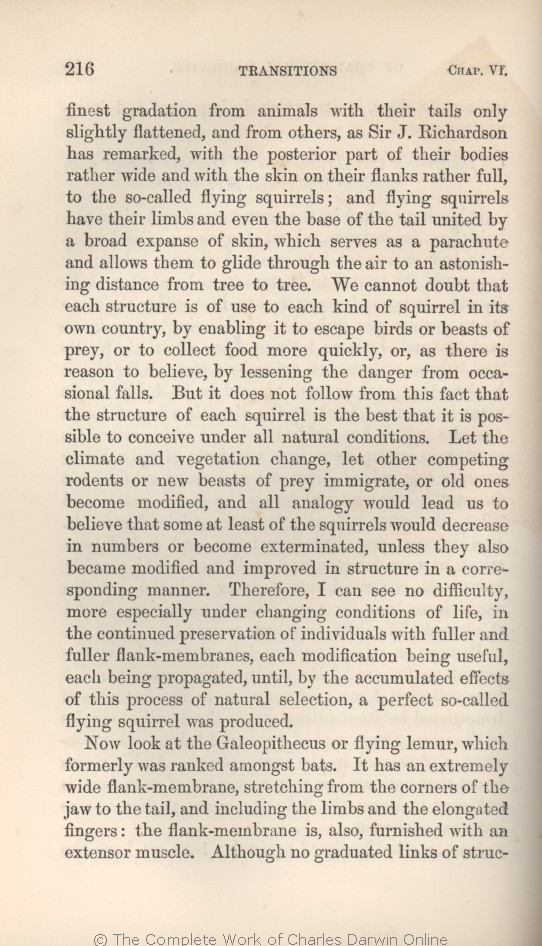finest gradation from animals with their tails only slightly flattened, and from others, as Sir J. Richardson has remarked, with the posterior part of their bodies rather wide and with the skin on their flanks rather full, to the so-called flying squirrels; and flying squirrels have their limbs and even the base of the tail united by a broad expanse of skin, which serves as a parachute and allows them to glide through the air to an astonishing distance from tree to tree. We cannot doubt that each structure is of use to each kind of squirrel in its own country, by enabling it to escape birds or beasts of prey,
or | or 1859 1860 1861 1866 1869 | or 1872 |
| by lessening 1859 1860 1861 1866 1869 | | to lessen 1872 |
| natural 1859 1860 1861 1866 1869 | | possible 1872 |
| until, 1866 1869 1872 | | until 1859 1860 1861 |
|
|
Now look at the Galeopithecus or
flying | flying 1859 1860 1861 1866 1869 | | so-called flying 1872 |
| ..... 1869 1872 | | falsely 1859 1860 1861 1866 |
| bats. 1859 1860 1861 1866 1869 |
| bats, but is now believed to belong to the Insectivora. 1872 |
| It has an 1859 1860 1861 1866 1869 |
| An 1872 |
| flank-membrane, 1859 1860 1861 1866 1869 | | flank-membrane 1872 |
| stretching 1859 1860 1861 1866 1869 | | stretches 1872 |
| including 1859 1860 1861 1866 1869 | | includes 1872 |
| and 1859 1860 1861 1866 1869 | | with 1872 |
| fingers: 1859 1860 1861 1866 1869 | | fingers. 1872 |
| the 1859 1860 1861 1866 1869 | the 1872 |
| flank-membrane 1860 1861 1866 1869 | flank-membrane 1872 | | flank membrane 1859 |
| is, 1859 1860 1861 1866 1869 | is, 1872 |
| also, 1859 1860 1861 1866 1869 | also, 1872 |
| furnished 1859 1860 1861 1866 1869 | furnished 1872 |
| with 1859 1860 1861 1866 1869 | with 1872 |
| an 1859 1860 1861 1866 1869 | an 1872 |
| extensor 1859 1860 1861 1866 1869 | extensor 1872 |
| muscle. 1859 1860 1861 1866 1869 | muscle. 1872 |
| 1 blocks not present in 1859 1860 1861 1866 1869; present in 1872 | | This flank-membrane is furnished with an extensor muscle.
|
| struc- ture, 1869 | | structure, 1859 1860 1861 1866 1872 |
|









